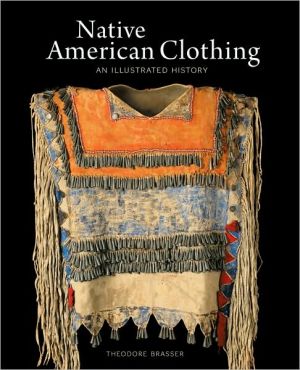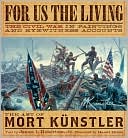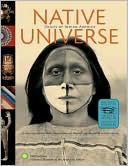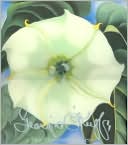Native American Clothing: An Illustrated History
More than five centuries of native peoples' artistry.\ Native Americans crafted beautiful clothing out of skins, pigment, quills and sinew. The collection of photographs in this outstanding reference celebrates this decorative genius. Many of the 300 photographs from more than 60 leading museums and private collections have never been published previously.\ The book describes the clothing in fascinating detail, from moccasins and tunics to sashes, bags and ceremonial and burial costumes....
Search in google:
More than five centuries of native peoples' artistry.Publishers WeeklyBrasser, a retired curator and an expert in the art and design of indigenous North Americans, has picked some 300 examples (from among thousands of artifacts residing in museums and private collections) for this lush, beautiful volume. Brasser breaks the collection into 12 regional groups which represent unique habitats, from the semi-tropical cultures of the Southeast to those of the High Arctic, moving in the direction of European contact, from south to north and from east to west). Each chapter includes a detailed map, the names and localities of various tribal groups, and relevant history, including what is known of pre-contact histories and the region's interaction with Europeans. Throughout, Brasser includes paintings made by European artists (from the early 16th through the mid-19th centuries) illustrating how native peoples were clothed and decorated at the time of initial contact. Historical essays describe a series of mostly tragic events, emphasizing the improbable survival of so many beautiful garments, bowls, rugs, bags, belts, and other artifacts. Featuring an amazing breadth of clothing design, motif, and technique, Brasser's volume makes an excellent cross-collection resource for anyone interested in indigenous art or Native American history. 300 color and b&w photos. Copyright © Reed Business Information, a division of Reed Elsevier Inc. All rights reserved.
Introduction / Crossing Beringia1 / In the Land of Corn Mother - Southeast 2 / The People of Dawnland - Northern East Coast 3 / Living on the Turtle's Back - Eastern Great Lakes 4 / Pleasing the Spirits - Eastern Sub-Arctic 5 / Between Sky and Underwater - Great Lakes 6 / By the Power of Their Dreams - Plains 7 / Born from This Earth - Southwest 8 / Of Diggers and Prophets - Plateau / Desert 9 / Paradise Lost - California 10 / In Celebration of Wealth - Northwest Coast 11 / Caribou - Western Sub-Arctic 12 / Hunters of the Arctic Coasts - ArcticReferences Photo Credits Index
\ Booklist - Barbara Jacobs\ [starred review] By their garments shall you know them. Brasser shares his substantial knowledge with readers as he meanders through 49 states and Canada and parts of northern Mexico to document the history of Native peoples. More than a runway of clothing, the more than 300 color photographs illustrate the similarities and differences among more than two dozen tribes. The author includes archival photographs, plus pictures of weapons, baby cradles, pottery, and baskets, in addition to the illustrations of beaded moccasins, skin shirts and skirts, elaborately plumed headdresses, and the like. The 12 chapters divide the three nations by geography, with early historical facts, maps, spiritual beliefs, and everyday customs, notes about language and assimilation as well as, sadly, the impact of climate change. This is a wise author who allows his pictures to represent one thousands words--and more.\ \ \ \ \ \ The Globe and Mail Holiday Round-UpA fashion book with a difference, this gorgeous coffee-table book featuring more than 300 colour and black-and-white photographs of native dress through the ages is penned by a Canadian anthropologist, art history professor and museum curator whose detailed and passionate commentary breathes life into each depicted artifact. Clothing as history.\ \ \ \ Maine Antiques DigestBrasser writes with solid foundations and with clarity about this subject. This survey comes alive for us first with the 300 illustrations. They are sumptuously presented and include early paintings of Native Americans and scarce portraits of tribal leaders dressed in their regalia.\ \ \ \ \ \ Medicine Hat NewsTheodore Brasser lays out a plush pictorial history of tribal groups in 12 regions across North America in [this] weighty, 368-page hardback.\ \ \ \ \ \ PW Online Weekly Exclusive PW Online Weekly Exclu[In] this lush, beautiful volume...Brasser breaks the collection into 12 regional groups which represent unique habitats...moving in the direction of European contact, from south to north and from east to west. Each chapter includes a detailed map, the names and localities of various tribal groups, and relevant history, including what is known of pre-contact histories and the region's interaction with Europeans. Throughout, Brasser includes paintings made by European artists...illustrating how native peoples were clothed and decorated at the time of initial contact. Historical essays describe a series of mostly tragic events, emphasizing the improbable survival of so many beautiful garments, bowls, rugs, bags, belts, and other artifacts. Featuring an amazing breadth of clothing design, motif, and technique, Brasser's volume makes an excellent cross-collection resource for anyone interested in indigenous art or Native American history.\ \ \ \ \ \ SciTech Book NewsAuthor Brasser (former curator National Museum of Ethnology, Netherlands, Canadian Museum of Civilization, Ottawa) provides a lavishly illustrated history and visual record of the clothing of native people from 12 regions of the North American continent. The 300 photographs, many of them published for the first time, are set in historical contexts covering topics such as agriculture, ceremonies, craftsmanship and materials, cultural identity, diet, the division of labor, hunting, migration routes, mythology, shamanism, and others.\ \ \ \ \ \ Winnipeg Free PressOne can't summon enough superlatives to describe this truly beautiful, definitive history of aboriginal clothing, organized into 12 regions covering all of North America. More than 300 superb photos document the artistry and ingenuity of indigenous people through artifacts such as leggings, moccasins and headdresses. Author Theodore Brasser, an academic and former curator at the Canadian Museum of Civilization, expertly traces the social and historical context of everything from Inuit parkas to Hopi masks in this simply stunning volume.\ \ \ \ \ \ Ontario Historical Society BulletinLavishly illustrated with more than 300 photographs from both museum and private collections...This is truly a gorgeous and thoroughly engaging book!\ \ \ \ \ \ VOYANative American Clothing: An Illustrated History is a one-stop compendium of images of and information about the clothing and decorative arts of the First People of all North American regions. The book introduces each region with relevant historical and geographical context. Images are typically captioned with comprehensive information, including a simple categorization, place or tribe of origin, date of use, description of use and remarkable visual features, and where the artifact is held. It is well indexed, and the photo credits will lead researchers to collections and museums to further investigate. While it may be useful for students to have access to such images online through a database, the breadth of this book cannot be matched by any typical art or history database or the Library of Congress American Memory collection. It is a useful first stop on a research project, as the information and images might pique interest in a region or tribe about which a student may not otherwise know. The book's large format and beautiful color images makes this title a worthy addition to any collection in need of information about Native American art and customs, or clothing tradition and design. While image-intensive books such as this one are typically expensive, Native American Clothing: An Illustrated History gives collection developers more bang for the buck, as it is a highly usable and beautifully formatted work, suitable for middle school through college-level researchers. Reviewer: Molly Krichten\ \ \ \ \ Publishers WeeklyBrasser, a retired curator and an expert in the art and design of indigenous North Americans, has picked some 300 examples (from among thousands of artifacts residing in museums and private collections) for this lush, beautiful volume. Brasser breaks the collection into 12 regional groups which represent unique habitats, from the semi-tropical cultures of the Southeast to those of the High Arctic, moving in the direction of European contact, from south to north and from east to west). Each chapter includes a detailed map, the names and localities of various tribal groups, and relevant history, including what is known of pre-contact histories and the region's interaction with Europeans. Throughout, Brasser includes paintings made by European artists (from the early 16th through the mid-19th centuries) illustrating how native peoples were clothed and decorated at the time of initial contact. Historical essays describe a series of mostly tragic events, emphasizing the improbable survival of so many beautiful garments, bowls, rugs, bags, belts, and other artifacts. Featuring an amazing breadth of clothing design, motif, and technique, Brasser's volume makes an excellent cross-collection resource for anyone interested in indigenous art or Native American history. 300 color and b&w photos. \ Copyright © Reed Business Information, a division of Reed Elsevier Inc. All rights reserved.\ \ \ \ \ Library JournalThis title presents 300 high-resolution color images of clothing, including shoes, scarves, hair ornaments, masks, leggings, and belts, created primarily in the 19th century by native North Americans. Divided into 12 chapters covering native culture, climate, and information about the arrival of Europeans, the essays are scholarly without being complicated. This detail-rich anthology is Brasser's (art history, Carleton Univ. & Trent Univ.) second book on Native American art and is padded with his scholarly background as curator for the National Museum of Ethnology, Netherlands, and the Canadian Museum of Civilization. VERDICT A good introduction to Native American culture and North American history for high school students and undergraduates, especially those interested in Native American clothing and art.—Valerie Nye, College of Santa Fe, NM\ \








